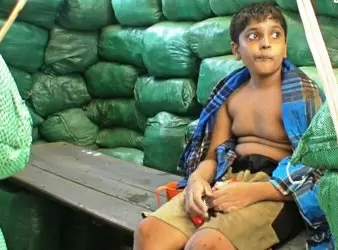Dragon’s feet in land of cold blooded murders

28-February-2013
Vol 4 | Issue 8
When the chilling new photographs of LTTE supremo Velupillai Pirapaharan’s 12-year-old son Balachandran captured and held in a sandbag bunker of the Sri Lankan Army and executed in cold blood and photographed again were published in the media recently, the international community was shocked but official India was unmoved.
Unlike his older brother Charles Antony and sister Dwarka, Balachandran never joined the LTTE, never bore arms against the Sri Lankan armed forces or anyone else. He was executed in cold blood because of his ethnicity and parentage. It was an extremely barbaric act.
 |
|
LTTE leader Prabakaran’s 12-year-old son was taken into custody, given snacks, and later shot dead by Sinhala soldiers
|
The photographic evidence is part of the third documentary by Britain’s Channel 4 titled “No War Zone: The Killing Fields of Sri Lanka,” which will be screened in Geneva in March ahead of a second resolution sponsored by the USA against the island nation at the UN Human Rights Council.
While most civilised world rallied behind a similar resolution last year to fix accountability of Sri Lanka’s war crimes and to take reparative steps, India made sure the text of the resolution was watered down to make it virtually ineffective.
As the 22nd session of the UNHRC began in Geneva this week, it is important to keep in mind that Sri Lanka government has ignored last year’s resolution and that it is not at all committed to implementing the recommendations prescribed in its own presidentially appointed Lessons Learnt and Reconciliation Commission.
The Human Rights Watch has called for the UNHRC to authorise an independent, international investigation into war crimes committed during the final months of Sri Lanka’s armed conflict.
It was of the opinion the Commonwealth community of nations may have some leverage because Sri Lanka is scheduled to host Commonwealth Heads of Government Meeting in November, a prestigious event for a small country.
A UN report compiled by its former spokesman in Colombo, Gordon Weiss, had said that about 40,000 people had been killed in the closing days of the civil war in May 2009. The Sri Lanka government, backed by a handful of nations with dubious human rights record, has been defiant even after the UNHRC resolution and has done precious little to implement it. In fact, it has become more brazen in muzzling free speech and civil liberties, and stripping down its constitutional institutions, including the judiciary.
The UN High Commissioner for Human Rights, Navy Pillay, said recently the Sri Lanka government was indulging in triumphalism in the Northern Province. She said that no mechanism had been established to trace people who went missing in the aftermath of the civil war and that investigations of disappearances had not led to any arrest or prosecution.
Civilians in the north have been prevented from commemorating victims of the war and more than 20,000 Tamil graves have been razed in the Vanni area where war museums and war memorials hailing Sinhala soldiers have been erected, Navi Pillay said.
She warned the triumphalist images will create a strong sense of alienation among the Tamil population. The Sri Lanka government has launched a systematic campaign to destroy Tamil culture and identity in the island nation.
Names of 89 Tamil villages and towns have been changed and given Sinhala names. Three hundred and sixty-seven Hindu temples have been demolished to make room for army camps. In the small district of Mullaitivu alone, there are 148 small and 13 large army camps.
Although the war has ended four years ago and the LTTE decapitated, the defence (offence?) budget for 2013 has been raised to Rs. 290 billion from Rs. 230 billion in 2012, representing 11.5 per cent of the budget.
The budget allocation for education is only 1.86 per cent of the GDP, which is the lowest in South Asia and one of the lowest in the world. The crisis in the education sector is compounded by closure of rural schools, particularly in Tamil areas, and militarisation of the education space.
When Mahinda Rajapaksa was elected President of Sri Lanka for the first time in 2005, he wanted to go down in history as the man who resolved the festering ethnic crisis which had already taken a heavy toll. He was also fully aware that without the active support and co-operation of India he could not accomplish his mission.
From the early days of his presidentship, he was sending emissaries holding the olive branch to New Delhi to build bridges only to be rebuffed contemptuously. He was keen on India constructing the Hambantota all-weather port in southern Sri Lanka. Nirupama Menon Rao, who was then India’s High Commissioner in Colombo, would not even forward the proposal to New Delhi.
Where India failed, China moved in with alacrity. Not willing to give up, Rajapaksa chose the back channel to find a solution. As it was beginning to show result, the Prime Minister’s Office in New Delhi intervened and blocked the channel and promised all assistance – moral, material and physical – to annihilate the LTTE. Rajapaksa found the offer tempting.
The turnaround in India’s Sri Lanka policy was brought about by four civilian officers whose primary objective was to promote the sphere of influence of China in the Indian Ocean rim States and keep the USA out. The PMO played along with this group.
The leader of this group is Shivshanker Menon who cut his teeth in the Indian Foreign Service as a junior officer in Beijing when he was bowled over by the Thoughts of Mao. He had two more postings in Beijing which helped the Chinese strengthen their ties with the Indian official.
Vijay Nambiar, a 1967 batch IFS officer, is fluent in Chinese language and has worked in India’s diplomatic missions in Hong Kong and Beijing among other palaces and developed close affinity with China.
Nirupama Rao also had a stint as India’s ambassador to China before becoming external affairs secretary.
The three, with former National Security Adviser MK Narayanan played a crucial role in reversing India’s time-tested Sri Lanka policy enunciated by Nehru and carried forward by Indira Gandhi.
The foundation of that policy was rested on the belief the Tamils in Sri Lanka are the natural ally of India while the Sinhalese are fair weather allies. This was proved time and again, most notably during the Bangladesh war.
Shortly before that, Sri Lanka faced its worst ever internal threat by the JVP insurrection. Unhesitatingly India pressed into service its Air Force and Navy to save the government of the day.
When the Bangladesh war broke out soon after, Pakistan found itself handicapped to rush troops and arms to its eastern wing as India refused right of its skies. Sri Lanka offered Pakistan use of its territory for transshipment of men and material and thereby delayed the liberation of Bangladesh by a few days.
The foreign office trio and Narayanan, in the name of fighting ‘international terrorism’ helped train and equip Sri Lankan armed forces to wipe out the LTTE and along with it the Tamil movement for autonomy.
For the final push, Rajapaksa sought the help of Lt.-Gen. Satish Nambiar, a retired Indian Army officer.
Vijay Nambiar, as adviser to the UN Secretary-General, had ensured the closing stages of the war was conducted without witnesses. India has much to answer for the atrocities Sri Lanka had committed.
The Northern and the Eastern Provinces, traditional homeland of the Tamils, have come under the virtual suzerainty of China. While Sri Lanka has not yet revoked the Indo-Sri Lanka Agreement of 1987, which promises autonomy to the provinces, Rajapaksa declared on the occasion of the Sri Lanka Independence Day recently that it was not practical for his country to grant autonomy to any province or ethnic group. “Equal rights to all communities” is his new mantra under which the Sinhala community is more equal than the rest.
Sam Rajappa is Consulting Editor of The Weekend Leader
















